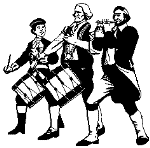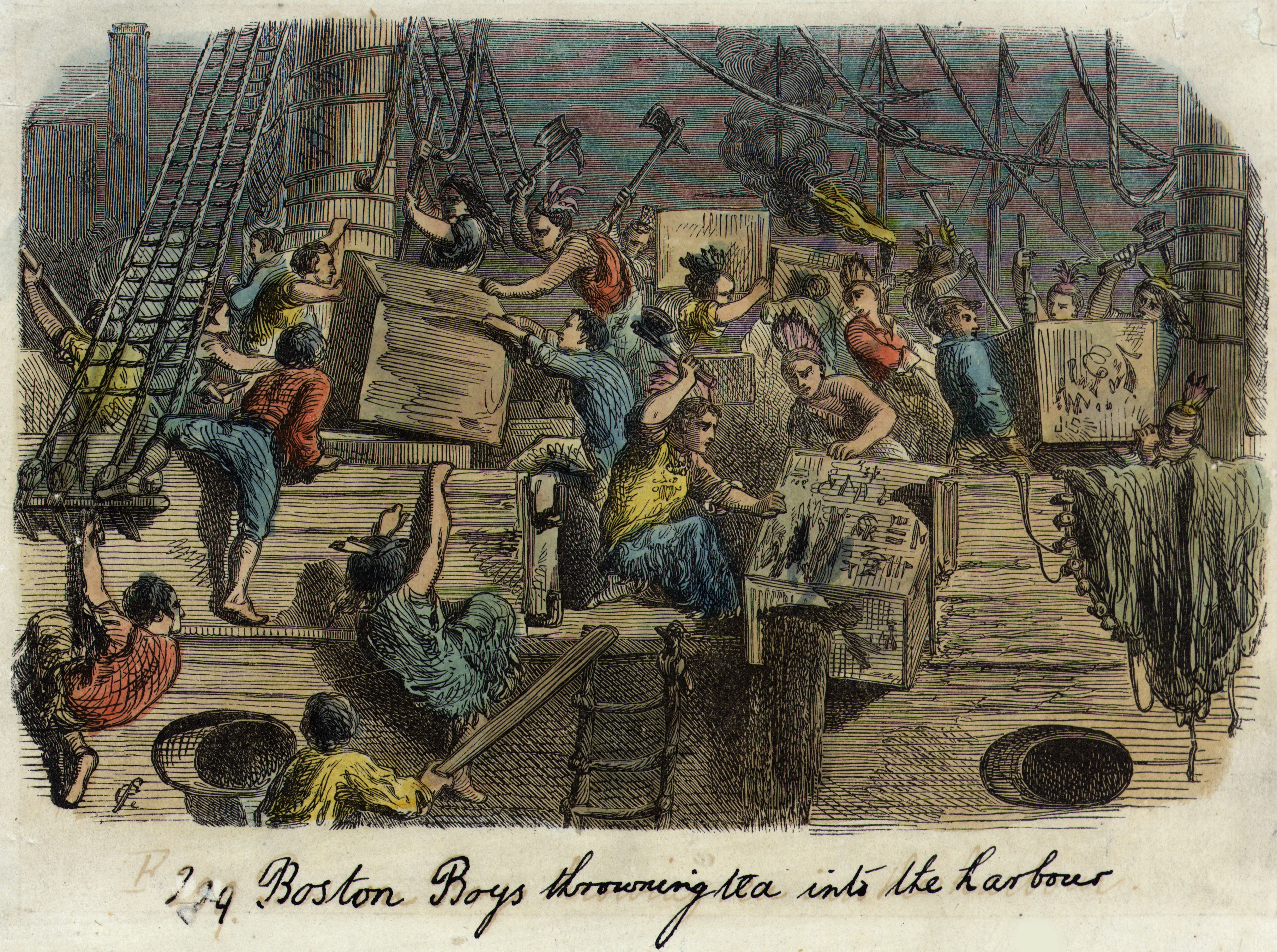
The
American Revolution
The
Boston Tea Party
(Dec.
16, 1773)

The Boston Tea Party was an act of
political and economic protest against the authority of
the far-away British government to impose taxes upon
American colonies that had no representation in Britain's
Parliament. The English subjects who lived in the
American colonies felt that they should have the same
political rights as other free-born Englishmen; in
particular, the right to have representatives sit in
Parliament and take part in the debates and creation of
laws that affected the colonies.
Following Britain's victory over
France in the French and Indian War, the British
government looked for ways to pay for the debts incurred
by the war. Since the war had largely been fought to
protect the English colonies in America, the government
felt it would be appropriate to let the American
colonists pay for their own defense through the
imposition of new taxes.
The Stamp Act and the Townsend Acts
had imposed multiple taxes on the American colonies as a
way to pay for British administration and defense of the
colonies. These taxes caused considerable political
agitation in America, leading to many protests. The most
violent protest culminated in the infamous Boston
Massacre of 1770, and the most celebrated act of
non-violent protest occurred three years later in what
came to be called the Boston Tea Party.
The British government repealed most
of the onerous tax laws that the Americans complained
about, but kept a tax on tea, which was a part of nearly
everyone's daily meals. The governement wanted to keep
the this tax in place largely to maintain its power to
levy taxes on the colonies. The American colonists
responded by refusing to let the tea ships of the East
India Company (which held the monopoly on shipping tea to
the colonies) dock and unload their taxable cargoes. Tea
ships bound for New York, Philadelphia, and Charleston
were all turned away. The tea ships bound for Boston
managed to dock, but were unable to unload their tea.
Thus, they sat at dock and waited.
When the East India Ship the
Dartmouth arrived in the Boston Harbor in late
November of 1773, Samuel Adams organized a meeting to be
held at Faneuil Hall on November 29. Several thousand
people arrived, forcing the meeting to be re-located to
the larger Old South Meeting House. Adams' meeting passed
a resolution, introduced by Adams, urging the captain of
the Dartmouth to leave Boston Harbor without paying the
import duty. Meanwhile, the meeting chose twenty-five men
to watch over the Dartmouth and ensure that the
tea was not unloaded.
Massachusetts Governor Hutchinson
refused to grant permission for the Dartmouth to
leave without paying the tax. Two more tea ships, the
Eleanor and the Beaver, arrived in Boston
Harbor On December 16, about 7,000 people had again
gathered at the Old South Meeting House. Upon hearing a
report that Governor Hutchinson still refused to let the
tea ships leave, Samuel Adams announced that "This
meeting can do nothing further to save the country."
According to eyewitness accounts, people did not leave
the meeting until ten or fifteen minutes after Adams's
alleged "signal," and Adams in fact tried to stop people
from leaving because the meeting was not yet
over.
While Samuel Adams tried to reassert
control of the meeting, quite a few Bostonians left the
Old South Meeting House and headed toward Boston Harbor.
Later that evening, a group of 30 to 130 men, some of
them dressed as Mohawk Indians, forced their way onto the
three tea ships, and, over the next three hours, dumped
all 342 chests of tea into Boston Harbor.
Samuel Adams, who was a professional
agitator, probably did not actually plan or aid the
effort to dump the tea, but he immediately saw the
propaganda value of the protest, and began working to
publicize and defend it this act of political protest.
Adams argued that the Tea Party was not the act of a
crazed mob, but arose out as the only response available
to the colonists who were defending their reasonable
principles and that they took this action as only
remaining option the people had to defend their
constitutional rights.
Governor Thomas Hutchinson had been
urging London to take a hard line with the Sons of
Liberty, as the main protest group involved in the Tea
Party was known.
Back in Britain, even those
politicians and members of Parliament normally friendly
to the plight of the colonies were shocked at this
apparent act of lawlessness they united with the more
conservative elements in Parliament against the colonies.
Prime Minister Lord North declared, "Whatever may be the
consequence, we must risk something; if we do not, all is
over." The British believed that the Tea Party could not
go unpunished and responded by closing the port of Boston
and put in place other laws known as the "Coercive
Acts".
In America, Benjamin Franklin stated
that the destroyed tea must be repaid, to the amount of
£90,000 (English Pounds). Robert Murray, a New York
merchant went to Lord North with three other merchants
and offered to pay for the losses, but the offer was
turned down. A number of colonists were inspired to carry
out similar acts, such as the burning of the Peggy
Stewart. The Boston Tea Party eventually proved to be
one of the major reactions leading up to the American
Revolutionary War, which began in April of
1775.
In February of 1775, Britain passed
the Conciliatory Resolution which ended taxation for any
colony which satisfactorily provided for the imperial
defense and the upkeep of British officers. This act did
not stop the momentum toward war that had been building
for many years.